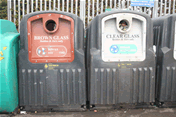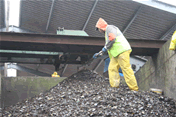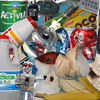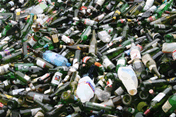
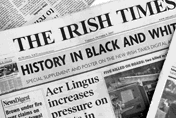
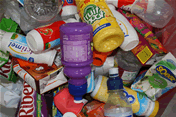
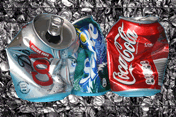
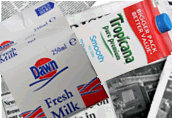
Glass is collected from bottlebanks keeping the clear, brown and green glass separate and also from domestic recycling bins where the glass mixed in with other recyclables is removed and separated into each colour at the picking station.
The glass is transported to a recycling processing plant where contaminants such as metal caps and plastic sleeves are removed.
The glass is then crushed into small pieces called cullet. It is now ready to be transported to a glass factory, Quinn Glass in Northern Ireland.
At the glass factory, the cullet is mixed with other raw materials to make glass (sand, limestone and soda ash) and melted in a large furnace.
The molten glass is moulded into new bottles and jars.
Facts and Figures
- One bottle bank can hold up to 3,000 bottles before it needs to be emptied.
- Glass makes up about 9% of all the rubbish we throw away.
- The energy saved from recycling one glass bottle will operate a 100-watt bulb for four hours.
- On average, every family in Ireland consumes around 500 glass bottles and jars every year - at the moment we recycle about 25% of these items.
- Glass is 100% recyclable and can be recycled over and over again to make new containers without any loss in quality.
- A glass jar recycled today will be back on the shelves in about 70 days.
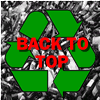
How is Paper and Cardboard Recycled?
Used newspaper, magazines, cardboard boxes etc., are collected from paper banks and various recycling schemes, compacted into one tonne bales and transported to the paper mill, Smurfit Recycling, Dublin.
At the paper mill, conveyor belts feed the old paper into the Fiber Preparation Plant, where it goes into the giant pulpers.
Water and chemicals are mixed with the waste paper inside the pulpers. This washes the ink and other contaminents off the paper fibers. The soggy, mushy paper is now called pulp.
The pulp is then injected between two wire meshes to form a damp paper sheet. This is dried to form the new recycled paper.
The dried paper is polished and then rolled into jumbo reels, some 9.2 metres wide and weighing more than 30 tonnes. The paper reels are then cut into smaller sizes to be sold.
Facts and Figures
- Approximately 400,000 tonnes of paper and cardboard packaging is placed on the Irish market every year.
- Each family uses about six trees worth of paper every year and makes almost 20% of the weight of the average household bin.
- Recycling one tonne of paper saves enough energy to power a computer for almost a year.
- Recycling one tonne of paper/cardboard saves over eight cubic metres of landfill space.
- Paper recycled today will be back on the shelf in about 60 days.

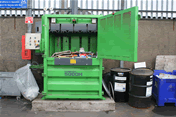
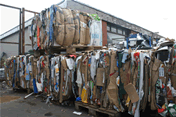

Plastic bottles for recycling are collected from bottle banks and various recycling schemes and brought by lorry to a recycling facility. They are sorted and squashed into large blocks.
The blocks are transported to a factory, Delleve Plastics in England where they are cut into small flakes- like little colourful corn flakes. The flakes are washed and dried, then taken away to be melted and made into new plastic objects.
Water and fizzy drinks bottles are usually made out of PET plastic. PET is recycled into dozens of products; t-shirts, sweaters, tennis shoes, carpets, tennis balls, sleeping bags, signposts window boxes, drainage pipes, combs, car bumpers, var parts, boat sails and furniture.
Milk and juice jugs and detergent bottles are typically made from HDPE plastic. They will come back to stores as new containers or show up in parks and parks as playground equipment, on back yard decks as plastic lumber, and in car parks as speed bumps and parking blocks.
Facts and Figures
- Approximately 700 million PET/HDPE bottles are placed on the Irish market every year.
- Plastic makes up 2.3% of the weight and 10% of the volumn of the average household bin.
- Recycling 1 plastic bottle saves enough energy to run a 60 watt bulb for 6 hours.
- It takes about 25 recycled drinks bottles tomake one fleece jacket

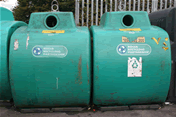


Aluminium cans are collected from can banks and various recycling schemes and brought by lorry to a recycling facility.The cans are sorted, then squashed together into big bales. They are transported by lorry to the aluminium can recycling factory, Alcan in England.
At the factory the bales are shredded into small pieces and cleaned. The shreds are melted down into big blocks of aluminium, called ingots. The ingots are rolled like pastry into very thin coiled sheets. New cans are made out of these coils. The cans are filled with drinks and sent to the shops to be sold and the whole cycle starts again.
You can also find recycled aluminium in aeroplanes, bicycles, foil, toys and electronics.
Facts and Figures
- Recycling aluminium uses only 5% of the power needed to to make aluminium from raw materials. In other words, 20 cans made from recycled aluminium use the same power as just one can made from new aluminium.
- Aluminium uses alot of raw materials - 5 tonnes of bauxite (aluminium ore) is needed to make one tonne of cans. So much electricity is needed that smelting plants need their own power plants.
- The energy saved from recycling one aluminium can will operate a computer for three hours.
- Used aluminium cans are recycled and returned to store shelves as new cans in as little as 60 days.
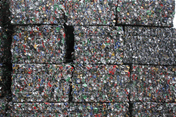


How are Beverage Cartons Recycled?
Beverage cartons (milk, juice and soup cartons) are collected through various rectcling schemes and brought to a recycling facility. They are baled and sent to a paper mill to be prosessed. At the mill the bales are shredded and cleaned. The shredded bales are now mixed with chemicals in a drum pulper. The cleaned pulp is sent to a paper machine where it is polished and rolled into huge rolls of new paper.
These huge rolls are sold on to other factories which produce new cardboard boxes, envelopes, tissue products etc,.
Facts and Figures
- Approximately 400 million beverage cartons are placed on the Irish market every year.
- Beverage cartons make up 1% of the weight of the average household bin.
- Households are the main source of used beverage cartons, with small amounts coming from retail and industrial sectors.
- Beverage cartons aure 75-80% wood fibre - a natural renewable resource.
- Used beverage cartons can be recycled into products such as paper reels, paper bags, stationery, tissue products etc,.






